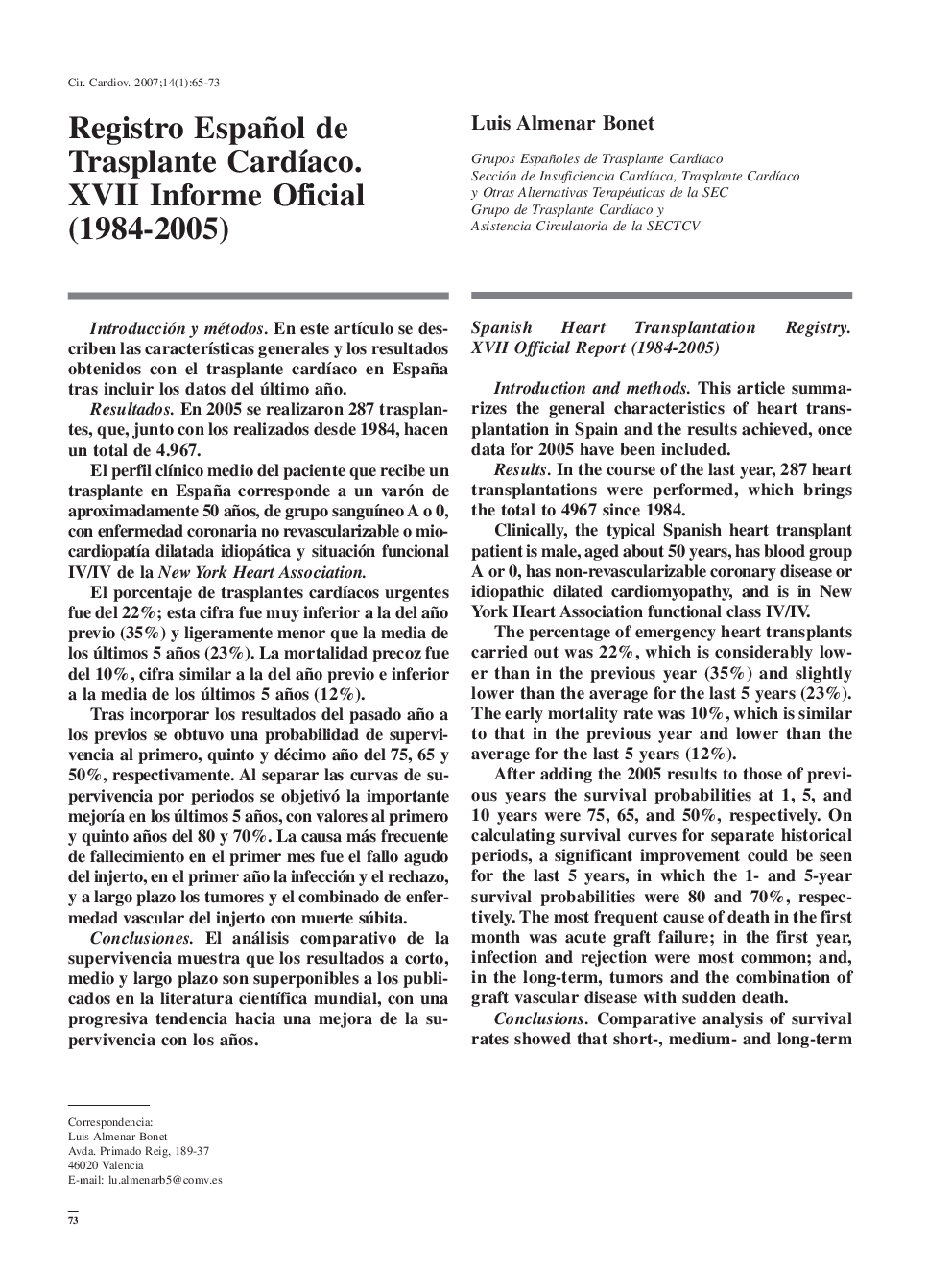| کد مقاله | کد نشریه | سال انتشار | مقاله انگلیسی | نسخه تمام متن |
|---|---|---|---|---|
| 2908180 | 1174064 | 2007 | 9 صفحه PDF | دانلود رایگان |

Introducción y métodosEn este artículo se describen las características generales y los resultados obtenidos con el trasplante cardíaco en España tras incluir los datos del último año.ResultadosEn 2005 se realizaron 287 trasplantes, que, junto con los realizados desde 1984, hacen un total de 4.967.El perfil clínico medio del paciente que recibe un trasplante en España corresponde a un varón de aproximadamente 50 años, de grupo sanguíneo A o 0, con enfermedad coronaria no revascularizable o miocardiopatía dilatada idiopática y situación funcional IV/IV de la New York Heart Association.El porcentaje de trasplantes cardíacos urgentes fue del 22%; esta cifra fue muy inferior a la del año previo (35%) y ligeramente menor que la media de los últimos 5 años (23%). La mortalidad precoz fue del 10%, cifra similar a la del año previo e inferior a la media de los últimos 5 años (12%).Tras incorporar los resultados del pasado año a los previos se obtuvo una probabilidad de supervivencia al primero, quinto y décimo año del 75, 65 y 50%, respectivamente. Al separar las curvas de supervivencia por periodos se objetivó la importante mejoría en los últimos 5 años, con valores al primero y quinto años del 80 y 70%. La causa más frecuente de fallecimiento en el primer mes fue el fallo agudo del injerto, en el primer año la infección y el rechazo, y a largo plazo los tumores y el combinado de enfermedad vascular del injerto con muerte súbita.ConclusionesEl análisis comparativo de la supervivencia muestra que los resultados a corto, medio y largo plazo son superponibles a los publicados en la literatura científica mundial, con una progresiva tendencia hacia una mejora de la supervivencia con los años.
Introduction and methodsThis article summarizes the general characteristics of heart transplantation in Spain and the results achieved, once data for 2005 have been included.ResultsIn the course of the last year, 287 heart transplantations were performed, which brings the total to 4967 since 1984.Clinically, the typical Spanish heart transplant patient is male, aged about 50 years, has blood group A or 0, has non-revascularizable coronary disease or idiopathic dilated cardiomyopathy, and is in New York Heart Association functional class IV/IV.The percentage of emergency heart transplants carried out was 22%, which is considerably lower than in the previous year (35%) and slightly lower than the average for the last 5 years (23%). The early mortality rate was 10%, which is similar to that in the previous year and lower than the average for the last 5 years (12%).After adding the 2005 results to those of previous years the survival probabilities at 1, 5, and 10 years were 75, 65, and 50%, respectively. On calculating survival curves for separate historical periods, a significant improvement could be seen for the last 5 years, in which the 1- and 5-year survival probabilities were 80 and 70%, respectively. The most frequent cause of death in the first month was acute graft failure; in the first year, infection and rejection were most common; and, in the long-term, tumors and the combination of graft vascular disease with sudden death.ConclusionsComparative analysis of survival rates showed that short-, medium- and long-term outcomes in Spain are consistent with those reported in the world literature, including a continuing trend towards better survival over the years.
Journal: Cirugía Cardiovascular - Volume 14, Issue 1, January–March 2007, Pages 65-73